
The Pinwheel Galaxy is a face-on spiral galaxy 21 million light-years away from Earth in the constellation Ursa Major. It was discovered by Pierre Méchain in 1781 and was communicated that year to Charles Messier, who verified its position for inclusion in the Messier Catalogue as one of its final entries.

Centaurus A is a galaxy in the constellation of Centaurus. It was discovered in 1826 by Scottish astronomer James Dunlop from his home in Parramatta, in New South Wales, Australia. There is considerable debate in the literature regarding the galaxy's fundamental properties such as its Hubble type and distance. NGC 5128 is one of the closest radio galaxies to Earth, so its active galactic nucleus has been extensively studied by professional astronomers. The galaxy is also the fifth-brightest in the sky, making it an ideal amateur astronomy target. It is only visible from the southern hemisphere and low northern latitudes.
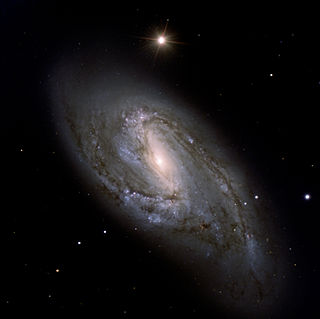
Messier 66 or M66, also known as NGC 3627, is an intermediate spiral galaxy in the southern, equatorial half of Leo. It was discovered by French astronomer Charles Messier on 1 March 1780, who described it as "very long and very faint". This galaxy is a member of a small group of galaxies that includes M65 and NGC 3628, known as the Leo Triplet or the M66 Group. M65 and M66 are a common object for amateur astronomic observation, being separated by only 20′.

NGC 6946, sometimes referred to as the Fireworks Galaxy, is a face-on intermediate spiral galaxy with a small bright nucleus, whose location in the sky straddles the boundary between the northern constellations of Cepheus and Cygnus. Its distance from Earth is about 25.2 million light-years or 7.72 megaparsecs, similar to the distance of M101 in the constellation Ursa Major. Both were once considered to be part of the Local Group, but are now known to be among the dozen bright spiral galaxies near the Milky Way but beyond the confines of the Local Group. NGC 6946 lies within the Virgo Supercluster.

NGC 2841 is an unbarred spiral galaxy in the northern circumpolar constellation of Ursa Major. It was discovered on 9 March 1788 by German-born astronomer William Herschel. J. L. E. Dreyer, the author of the New General Catalogue, described it as, "very bright, large, very much extended 151°, very suddenly much brighter middle equal to 10th magnitude star". Initially thought to be about 30 million light-years distant, a 2001 Hubble Space Telescope survey of the galaxy's Cepheid variables determined its distance to be approximately 14.1 megaparsecs or 46 million light-years. The optical size of the galaxy is 8.′1 × 3.′5.
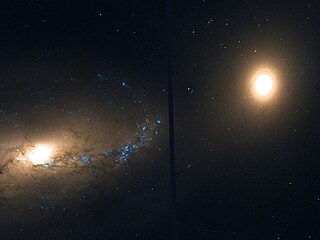
NGC 3226 is a dwarf elliptical galaxy that is interacting with the spiral galaxy NGC 3227. The two galaxies are one of several examples of a spiral with a dwarf elliptical companion that are listed in the Atlas of Peculiar Galaxies. Both galaxies may be found in the constellation Leo. It is a member of the NGC 3227 Group of galaxies, which is a member of the Leo II Groups, a series of galaxies and galaxy clusters strung out from the right edge of the Virgo Supercluster.

NGC 4088 is an intermediate spiral galaxy in the constellation Ursa Major. The galaxy forms a physical pair with NGC 4085, which is located 11′ away.
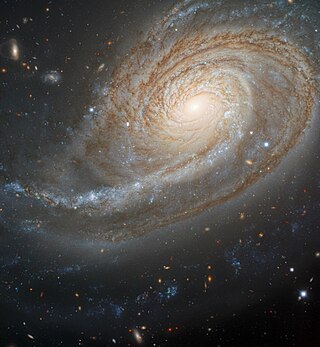
NGC 772 is an unbarred spiral galaxy approximately 130 million light-years away in the constellation Aries.

The Atlas of Peculiar Galaxies is a catalog of peculiar galaxies produced by Halton Arp in 1966. A total of 338 galaxies are presented in the atlas, which was originally published in 1966 by the California Institute of Technology. The primary goal of the catalog was to present photographs of examples of the different kinds of peculiar structures found among galaxies.

NGC 4618 is a distorted barred dwarf galaxy in the constellation Canes Venatici. The galaxy is formally classified as a Sm galaxy, which means that its structure vaguely resembles the structure of spiral galaxies. The galaxy is sometimes referred to as a Magellanic spiral because of its resemblance to the Magellanic clouds.
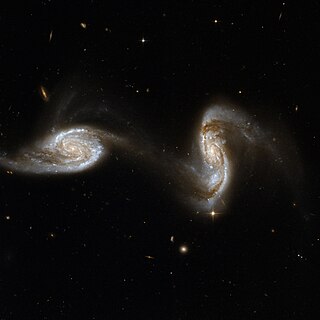
Arp 240 is a pair of interacting spiral galaxies located in the constellation Virgo. The two galaxies are listed together as Arp 240 in the Atlas of Peculiar Galaxies. The galaxy on the right is known as NGC 5257, while the galaxy on the left is known as NGC 5258. Both galaxies are distorted by the gravitational interaction, and both are connected by a tidal bridge, as can be seen in images of these galaxies.
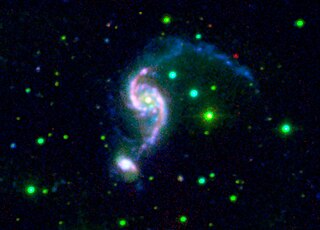
NGC 2536 is a barred spiral galaxy with a prominent inner ring structure encircling the bar in the constellation Cancer that is interacting with NGC 2535. The two galaxies are listed together in the Atlas of Peculiar Galaxies as an example of a spiral galaxy with a high surface brightness companion.

NGC 1672 is a barred spiral galaxy located in the constellation Dorado. It was discovered by the astronomer James Dunlop on November 5, 1826. It was originally unclear whether it was a member of the Dorado Group, with some sources finding it to be a member and other sources rejecting its membership. However, recent tip of the red-giant branch (TRGB) measurements indicate that NGC 1672 is located at the same distance as other members, suggesting it is indeed a member of the Dorado Group.

NGC 5962 is a spiral galaxy in the equatorial constellation of Serpens Caput. It was discovered by the Anglo-German astronomer William Herschel on March 21, 1784. The NGC 5962 galaxy is located at a distance of 120 million light years and is receding with a heliocentric radial velocity of 1,957 km/s. It is the brightest member of the eponymously-named NGC 5962 group, which overlaps with the nearby NGC 5970 group; the two groups may be gravitationally bound.

NGC 2608 is a barred spiral galaxy located 93 million light-years away in the constellation Cancer. It is 62,000 light-years across, and about 60% of the width of the Milky Way. It is considered a grand design spiral galaxy and is classified as SB(s)b, meaning that the galaxy's arms wind moderately around the prominent central bar.
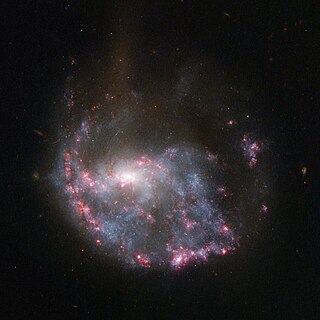
NGC 922 is a peculiar galaxy in the southern constellation of Fornax, located at a distance of 142 Mly from the Milky Way. It is one of the nearest known collisional galaxies. This object was described by the Herschels as "considerably faint, pretty large, round, gradually pretty much brighter middle." The general form is described by the morphological classification of SB(s)cd pec, which indicates a peculiar (pec) barred spiral galaxy (SB) with no inner ring system around the bar (s) and loosely-wound spiral arms (cd).
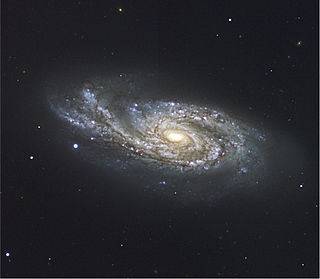
NGC 908 is an unbarred spiral galaxy in the constellation Cetus. It was discovered in 1786 by William Herschel. This galaxy is 56 million light years away from Earth. It is the main galaxy in the NGC 908 group, which also includes NGC 899, NGC 907, and IC 223.

NGC 1614 is the New General Catalogue identifier for a spiral galaxy in the equatorial constellation of Eridanus. It was discovered on December 29, 1885 by American astronomer Lewis Swift, who described it in a shorthand notation as: pretty faint, small, round, a little brighter middle. The nebula was then catalogued by Danish-Irish astronomer J. L. E. Drayer in 1888. When direct photography became available, it was noted that this galaxy displayed some conspicuous peculiarities. American astronomer Halton Arp included it in his 1966 Atlas of Peculiar Galaxies. In 1971, Swiss astronomer Fritz Zwicky described it as a "blue post-eruptive galaxy, compact patchy core, spiral plumes, long blue jet SSW".
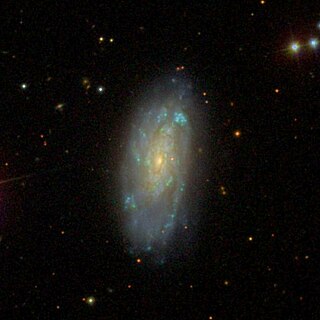
NGC 7448 is a spiral galaxy located in the constellation Pegasus. It is located at a distance of circa 80 million light years from Earth, which, given its apparent dimensions, means that NGC 7448 is about 60,000 light years across. It was discovered by William Herschel on October 16, 1784. It is included in the Atlas of Peculiar Galaxies in the category galaxies with detached segments.
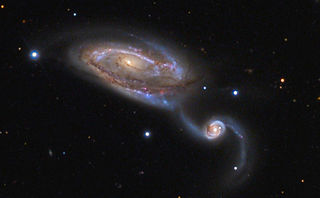
NGC 5395 is an interacting spiral galaxy located at a distance of 160 million light years, but receding away from the Earth at 3511 kilometers per second, in the constellation Canes Venatici. It was discovered by William Herschel on May 16, 1787. NGC 5395 and NGC 5394 are included in the Atlas of Peculiar Galaxies as Arp 84 in the category "Spiral galaxies with large high surface brightness companions".




















